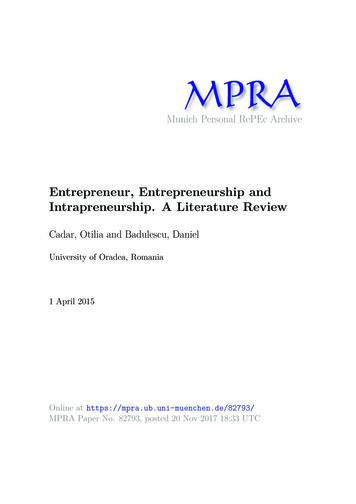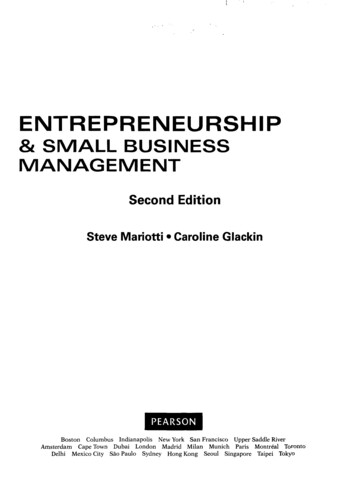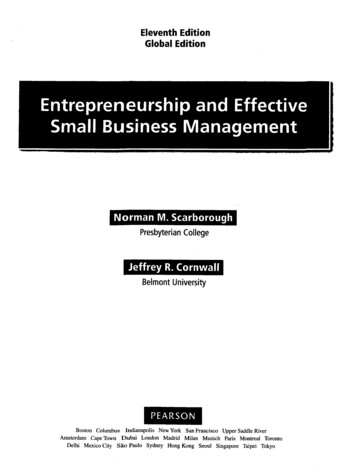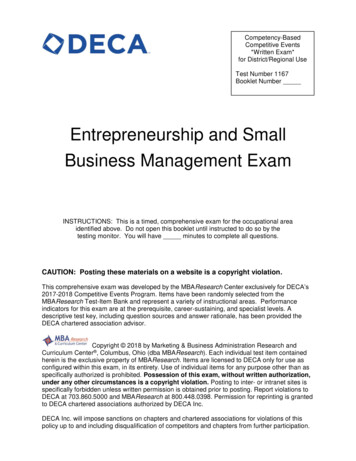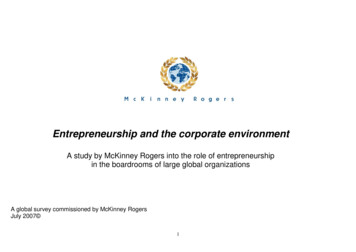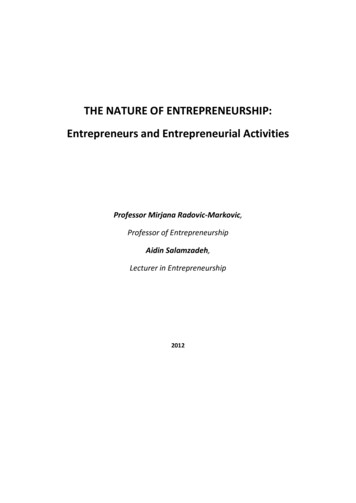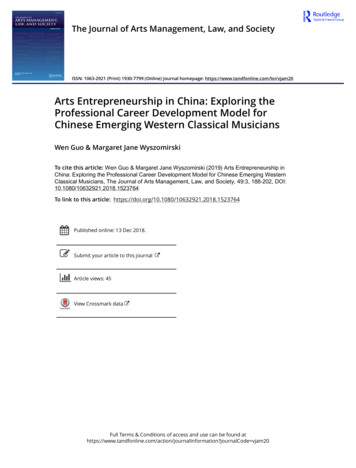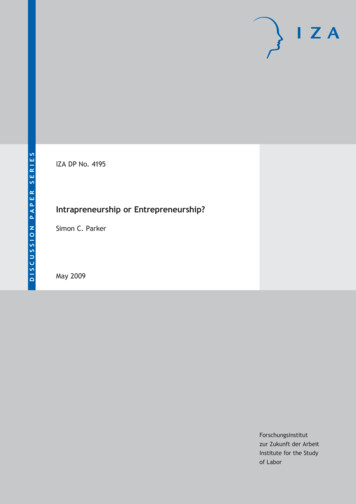
Transcription
SERIESPAPERDISCUSSIONIZA DP No. 4195Intrapreneurship or Entrepreneurship?Simon C. ParkerMay 2009Forschungsinstitutzur Zukunft der ArbeitInstitute for the Studyof Labor
Intrapreneurship or Entrepreneurship?Simon C. ParkerUniversity of Western Ontarioand IZADiscussion Paper No. 4195May 2009IZAP.O. Box 724053072 BonnGermanyPhone: 49-228-3894-0Fax: 49-228-3894-180E-mail: iza@iza.orgAny opinions expressed here are those of the author(s) and not those of IZA. Research published inthis series may include views on policy, but the institute itself takes no institutional policy positions.The Institute for the Study of Labor (IZA) in Bonn is a local and virtual international research centerand a place of communication between science, politics and business. IZA is an independent nonprofitorganization supported by Deutsche Post Foundation. The center is associated with the University ofBonn and offers a stimulating research environment through its international network, workshops andconferences, data service, project support, research visits and doctoral program. IZA engages in (i)original and internationally competitive research in all fields of labor economics, (ii) development ofpolicy concepts, and (iii) dissemination of research results and concepts to the interested public.IZA Discussion Papers often represent preliminary work and are circulated to encourage discussion.Citation of such a paper should account for its provisional character. A revised version may beavailable directly from the author.
IZA Discussion Paper No. 4195May 2009ABSTRACTIntrapreneurship or Entrepreneurship?I explore the factors that determine whether new business opportunities are exploited bystarting a new venture for an employer (‘nascent intrapreneurship’) or independently(‘nascent entrepreneurship’). Analysis of a nationally representative sample of Americanadults gathered in 2005-06 uncovers systematic differences between the drivers of nascententrepreneurship and nascent intrapreneurship. Nascent entrepreneurs tend to leverage theirgeneral human capital and social ties to organize ventures which sell directly to customers,whereas intrapreneurs disproportionately commercialize unique new opportunities which sellto other businesses. Implications of the findings are discussed.JEL Classification:Keywords:L26, M13nascent entrepreneurship, intrapreneurship, sample selectionCorresponding author:Simon C. ParkerRichard Ivey School of BusinessUniversity of Western Ontario1151 Richmond StLondon, Ontario N6A 3K7CanadaE-mail: sparker@ivey.uwo.ca
Intrapren eurship or E n trepren eurship?21.IntroductionIntrapreneurship — also known as corporate entrepreneurship and corporate venturing (Burgelman1983; Burgelman 1984; MacMillan et. al. 1986) — is the practice of developing a new venturewithin an existing organization, to exploit a new opportunity and create economic value (Pinchot1985). Entrepreneurship by contrast is the act of developing a new venture outside an existingorganization. There is evidence that intrapreneurship helps managers to renew and revitalize theirbusinesses, to innovate, and to enhance their overall business performance (Kuratko et. al. 1990;Antoncic and Hisrich 1990). It is therefore of interest to investigate which factors are associated withe orts to start new ventures for an employer by ‘nascent intrapreneurs’, and which are associatedinstead with independent start-ups by ‘nascent entrepreneurs’ — where the word ‘nascent’ refersto emergent (i.e., not yet completed) start-up activity. The present article explores this question.Previous research has identi ed several reasons why new opportunities might be exploited viaentrepreneurship rather than intrapreneurship. These include agency costs which a ect contractingbetween employees and employers; transferable human capital and limited asset complementaritywithin existing rms; and organizational limitations of incumbents such as bureaucracy and rigidroutines (Henderson 1993; Anton and Yao 1995; Klepper 2001; Helfat and Lieberman 2002). However, to date there is only limited empirical evidence about the factors promoting entrepreneurshiprather than intrapreneurship. Instead, the evidence base is mainly concerned with: linking the market entry strategies and performance outcomes of new spino s to the performance of parent rms(Christensen 1993; Helfat and Lieberman 2002; Gompers et. al. 2005; Klepper and Thompson 2006);organizational factors which in‡uence intrapreneurship (Pinchot 1985; Hornsby et. al. 2002); thee ects of intrapreneurship on corporate performance (Lumpkin and Dess 1996; Zahra and Gravis2000); and characteristics of intrapreneurs (Fayolle 2004; Howell and Higgins 1990a).This article develops theoretical arguments and testable hypotheses about the factors promotingnascent intrapreneurship relative to nascent entrepreneurship. These arguments principally drawon contributions from human capital theory and incentive (agency) theory. The article utilizes datafrom a relatively large and representative publicly–available survey of American adults, the PSED
Intrapren eurship or E ntrepreneurship?3II (www.psed.isr.umich.edu). This dataset makes a clean distinction between NE and NI startups, and contains a rich array of explanatory variables about individuals and their products; theprocesses they follow; and the organizational environments they operate in, including informationabout their current or former employers (Aldrich 1999; Menzel et. al. 2007). The PSED II alsocontains information about people who choose neither intrapreneurship nor entrepreneurship. Thismakes it possible to deal with the possibility that nascent intrapreneurs and entrepreneurs self-selectnon-randomly into these activities.Dealing with sample selection turns out to be crucial for deriving accurate empirical results. The ndings reveal a central role for general human capital, which promotes start-up organizing e ortsin general, and nascent entrepreneurship (rather than nascent intrapreneurship) in particular. Whileprevious research has already identi ed general human capital as an important determinant ofstart-up e orts in general (e.g. Davidsson and Honig 2003), its in‡uence on NE relative to NI isless well known. Furthermore, it is found that independent starts are more likely to exploit ideaswhich involve talking to customers rather than researching established competitors, and whichleverage social ties as well as general human capital. In contrast, incumbent rms tend to pursueintrapreneurship by developing unique business-to-business products which seem to be harder foremployees to transfer into independent start-up e orts.We believe that these results are not only interesting in their own right but also could proveinformative for theory and practice. For example, because the (observable) characteristics of individuals, their current or more recent workplaces, and their proposed new products all turn out toa ect the decision to do NI or NE, future theories might need to be enriched to draw on a broaderrange of considerations than has been the case hitherto. In particular, our ndings suggest the needfor future theory to extend the scope of inquiry from that of the individual employee to take greateraccount of the objectives, capabilities and limitations of the organizations they work for. Strategic interactions between agents in this context are likely to be both interesting and wide-ranging.Future theory development might also fruitfully delve deeper into the self-selection mechanisms(based on unobservable characteristics) which our empirical investigation uncovers.
Intrapren eurship or E n trepren eurship?4The next section develops theoretical arguments and testable hypotheses about the factors promoting NI relative to NE. The section that follows it explains the dataset, including key explanatoryvariables and control variables. The fth section outlines the empirical methods used to test thehypotheses. The sixth section presents the results. The nal section concludes.2.TheoryA large body of theoretical research emphasizes the importance of human capital for understandingthe determinants of start-up organizing e orts. It is convenient at the outset to follow Becker (1964)by distinguishing between ‘general’and ‘speci c’human capital. General human capital comprisesskills, knowledge, experience and capabilities (such as those embodied in formal education) whichare useful in a multitude of productive uses, including both existing organizations and new venturecreation. Speci c human capital in contrast refers to skills, experience, knowledge and capabilities, such as those imparted by rm-speci c training programs, which are primarily useful to theorganization which provides them.The distinction between general and speci c human capital helps to elucidate implications of anagency problem studied by Anton and Yao (1995), in which an employee identi es a new ventureopportunity which can be exploited either inside or outside the rm. The employee can keep theopportunity secret, and quit the rm in order to exploit it in a new independent rm (NE); or shecan disclose it to the rm in the hope of sharing in the pro ts resulting from joint development(NI). The greater an employee’s general human capital, the greater is their capability to exploitthe opportunity outside the rm in independent NE (Zucker et. al. 1998). General human capitalis associated with analytical ability, knowledge about business opportunities and conditions, andcomputational and communication skills which are readily transferable between organizations. Incontrast, an employee’s general human capital may be less relevant for developing the opportunityvia NI if the rm can substitute other workers’general human capital to develop the idea once ithas been revealed to them. Hence one might expect general human capital to be more associatedwith NE than with NI activity.
Intrapren eurship or E ntrepreneurship?5The value of new venture opportunities discovered within rms is frequently enhanced by complementarities with other assets speci c to the rm (Teece 1986; Subramanian 2005). For example, anemployee’s speci c human capital can a ect the development trajectory of a new idea, culminatingin an innovation which is complementary to the internal organization of the rm and hence morevaluable if exploited within it. In such cases, intrapreneurship would appear to be a logical option.But although speci c human capital might be di cult to transfer outside incumbent rms owing toformal barriers (e.g. non-compete agreements) and informal barriers (e.g. embedded organizationalskills), it is less obvious which aspects of speci c human capital are truly speci c to the rms theyare acquired in. Indeed, several theories of independent spino s argue that ‘speci c’human capitalis actually more transferable outside the rm than it rst appears (Helfat and Lieberman 2002;Møen 2005).Consider, for example, knowledge about a rm’s internal organizational routines, which is animportant kind of speci c human capital (Nelson and Winter 1982; Klepper 2001). Although thisknowledge might be redundant in other incumbent rms, employees leaving a rm to start a newindependent venture might be able to replicate and transfer these routines to the new venture tobetter exploit their opportunities (Klepper 2001; Freeman and Engel 2007). In which case, whatappears to be speci c human capital might actually promote NE as well as NI activity, having moreambiguous e ects on choices of commercialization mode than general human capital does.These ideas are summarized in the following hypothesis:Hypothesis 1. General human capital makes NE more attractive relative to NI, and has strongere ects on the mode of commercialization than speci c human capital.Other rm-speci c assets include established marketing, sales, design and logistics departments,which are set up to service a rm’s existing operations but which can also work with a new internalproduct line. The existence of these assets; a reputation for providing a stable and trusted sourceof supply; and greater legitimacy relative to new independent start-ups, give incumbent rmsan advantage over new independent ventures in commercializing new opportunities, whether of
Intrapren eurship or E n trepren eurship?6the business-to-business (B2B) or business-to customer (B2C) sort. However, it seems likely thatincumbent rms have a comparative advantage over new ventures in B2B rather than B2C sales(Claycomb et. al. 2005). The reasoning is as follows. Few independent start-ups have access to theresources needed to supply other businesses (especially legitimacy and reputation), and instead arelikely to have a comparative advantage in forging B2C relationships whose e ectiveness dependson ‡exible adjustment to fast-changing consumer demand. In these circumstances, incumbents’routines can be a positive disadvantage, since redeploying resources from their current uses cancause ine ciencies as managers of incumbent rms strive to retain those resources to support theprojects for which they are responsible. This can allow independent entrepreneurship to exploitpro table (though possibly short-lived) niches (Audretsch and Thurik 2001; Freeman and Engel2007).Hypothesis 2. Business-to-business opportunities are associated more with NI than NE commercialization: business-to-customer opportunities are associated more with NE than NI.Anton and Yao (1995) argue that greater personal wealth enables an employee to contract moree ectively with their employer. Anton and Yao (1995) consider a contract under which, in returnfor posting a bond to the employer, an employee who chooses joint commercialization is guaranteeda stake of the pro ts. This contract removes the risk of expropriation by the employer and makesthe employee willing to reveal their discovery — so promoting NI commercialization. In contrast,employees lacking weal
1985). Entrepreneurship by contrast is the act of developing a new venture outside an existing organization. There is evidence that intrapreneurship helps managers to renew and revitalize their businesses, to innovate, and to enhance their overall business performance (Kuratko et. al. 1990; Antoncic and Hisrich 1990). It is therefore of interest to investigate which factors are associated with
